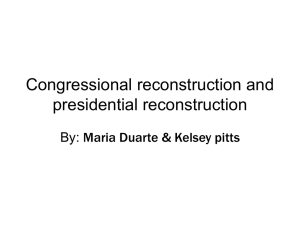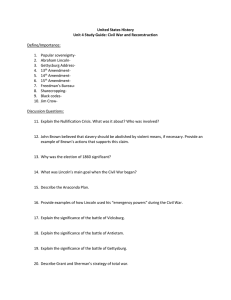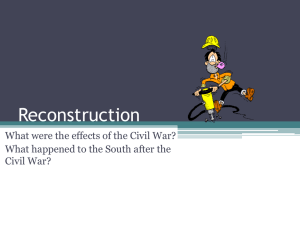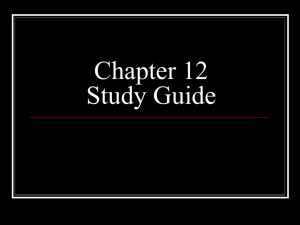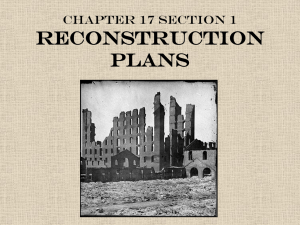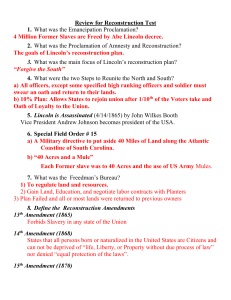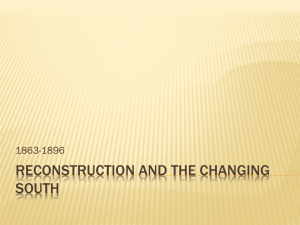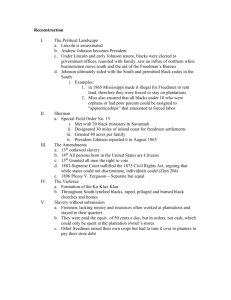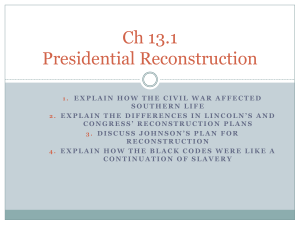Reconstruction (1865
advertisement
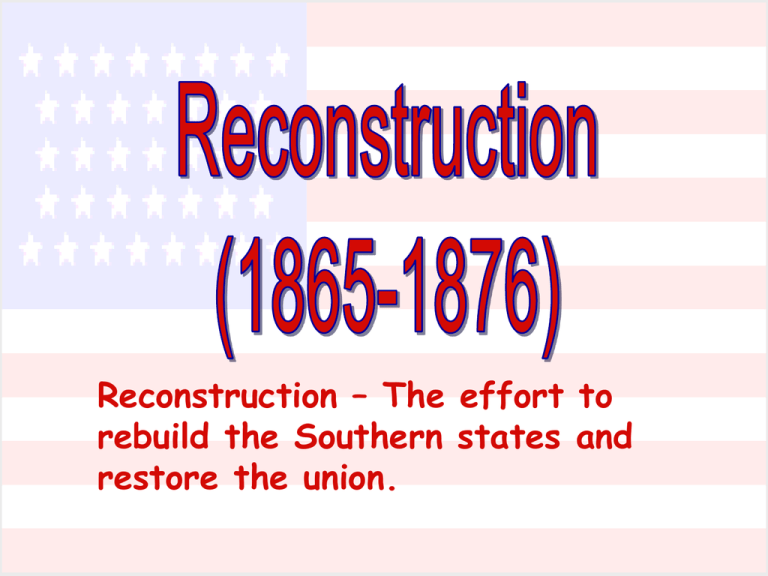
Reconstruction – The effort to rebuild the Southern states and restore the union. Key Questions 1. How do we bring the South back into the Union? 2. How do we rebuild the South after its destruction during the war? 4. What branch of government should control the process of Reconstruction? 3. How do we integrate and protect newlyemancipated black freedmen? President Lincoln’s Plan Lincoln had begun planning for the restoration of the South during the war. “With malice toward none, with charity for all, ...let us strive on to finish the work we are in, ...to do all which may achieve and cherish a just and lasting peace among ourselves and with all nations.” - A. Lincoln * Lincoln’s Primary concern was to restore the Union ASAP President Lincoln’s Plan Would pardon any Southerner who pledged an oath of Loyalty to the United States. Would not Pardon any Confederate officer or anyone who had killed African-American war prisoners. A state could resume full participation in the Union if 10% of its voters swore an oath of allegiance to the United States. Lincoln would be assassinated before he could carry out his plan President Andrew Johnson Lincoln’s V.P. Anti-Aristocrat. White Supremacist. Agreed with Lincoln that states had never legally left the Union. He intended to follow Lincoln’s Plan. Radical Republicans • Congress was controlled by “Radical Republicans” • The felt Lincoln & Johnson’s Reconstruction plans were too easy on the South. • Johnson did not listen to their plans for Reconstruction. • This led to Congress impeaching Johnson for “high crimes and misdemeanors” The Senate Trial 11 week trial. Johnson acquitted 35 to 19 (one short of required 2/3s vote). Although Johnson was acquitted he lost his political power Radical Reconstruction • Divided the South into 5 Military districts controlled by the Army while new state governments were being set up. Radical Reconstruction Continued… • New state governments in the South had to allow African American Males the right to vote, and recognize all African Americans as American citizens with full rights. • No former Confederate officer could hold a political office. • Many white Southerners deeply resented the Federal government’s imposition of Radical reconstruction and African American’s new role in politics. Reconstruction Amendments • 13th Amendment – Abolished Slavery in the United States. • 14th Amendment – Granted citizenship to all native-born or naturalized persons. • 15th Amendment – Declared states could not deny the right to vote because of race, color, or previous servitude (Slavery) Purpose: Black Codes * Aimed at keeping blacks in conditions similar to slavery * These were enforced in the South after the Military left * Meant to limit the impact of the new constitutional amendments. Sharecropping - [tenant farmers]. Blacks had to grow crops and give them to the land owner as payment. Owner still controlled them. Black Codes continued • Poll Taxes – voters had to pay a tax in order to vote. • Literacy Tests – Some states required voters to prove they could read and write before voting. • Grandfather Clauses – The son or Grandson of a man eligible to vote in 1866 could vote. Black Codes continued • Jim Crow Laws – Separated people on the basis of race. Forbade blacks from sharing facilities with whites such as: – – – – Railroad cars Water Fountains Schools Parks Public Buildings Black Codes continued • Secret Societies – Groups such as the KKK rose up to take treatment of blacks into their own hands. Plessy v. Ferguson 1896 • Supreme Court Rules that Segregation (the legal separation of races) was legal as long as African Americans had access to facilities that were equal to those of the white facilities. “Separate but Equal.”
